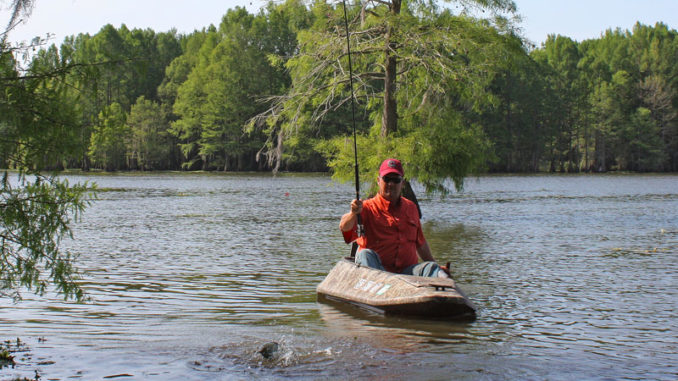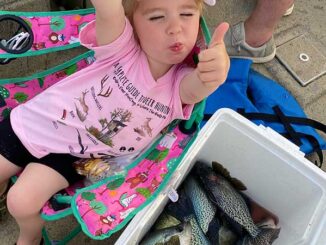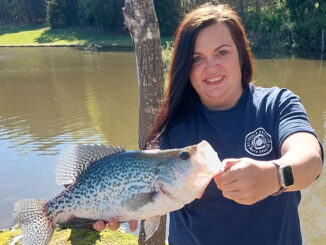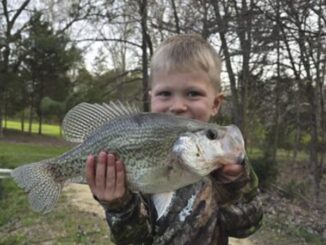
Santee Cooper anglers of all piscatorial pursuits love April because most game and panfish species are in shallow water either feeding, spawning or both.
Two angler favorites, shellcracker and crappie, provide outstanding fishing throughout the month, and fishermen flood to the Santee Cooper lakes to enjoy sensational fishing for both species.
Shellcrackers
For fishermen seeking bedding shellcrackers on Santee Cooper, the long wait is over. April is prime time to find shellcrackers bedding. They’re accessible in the shallows, enabling anglers to take limits of huge shellcrackers throughout lakes Marion and Moultrie.
The Santee Cooper lakes provide world-class fishing for shellcrackers. The state record, and one-time world record shellcracker, is 5 pounds, 7.5 ounces and was caught in the Diversion Canal in 1998.
Retired Santee Cooper fisheries biologist Scott Lamprecht said specific habitat and water conditions in the Santee Cooper system enables these fish to grow to extraordinary sizes.
One reason is shellcrackers live a long time, considerably longer than most panfish.
“Shellcrackers can live over 10 years in the Santee Cooper system and a bluegill may live five years,” he said. “That’s a big difference, plus the habitat and food supply in the Santee Cooper system is ideal for growing shellcrackers.”
Plentiful food
He said food sources include mussels, clams and snails as well as insect larva and other benthic invertebrates, all of which are found in great supply. Shellcrackers thrive in shallow, moving water with food-rich environments. Fortunately for shellcracker fishermen, that’s exactly what occurs at Santee Cooper.
Lamprecht said a full moon during late-April is often the peak bedding period, but bedding usually occurs a month prior and even well after the peak.
Santee Cooper anglers show this big panfish species a lot of love, and during April the shellcrackers love them back by clustering in huge beds with a strong willingness to eat any worm or cricket that dares to intrude. The result is these big, strong-fighting panfish quickly fill up empty space in large coolers.
The shallow water areas of both lakes Marion and Moultrie are prime shellcracker targets during April.
Most experienced Santee Cooper shellcracker fishermen employ a 10- to 12-foot pole and flip worms or crickets around trees, logs, stumps and weeds when targeting shellcrackers. When they catch one, they slow down and search the area thoroughly. Often, catching that one fish during April signals that a whole bunch of them may lurk nearby.
Go long
The advantage of the long pole at Santee Cooper is two-fold. First, shellcracker beds are often found deep in gnarly cover with limbs and trees complicating the ability to cast, limiting the effectiveness of spinning or spin-cast tackle. The long pole can be guided through, around or over obstructions to reach the target.
Second, the long pole enables fishermen to drop the bait exactly where they want it. Close is usually not close enough for shellcrackers. Hitting the target perfectly may result in multiple big shellcrackers yanked from the exact same spot.
Shellcrackers are caught on both crickets or worms, but redworms or nightcrawlers are the ‘go-to’ bait for diehard shellcracker anglers. They’re more time consuming to bait up, but are preferred when specifically targeting shellcrackers.
Experienced shellcracker anglers stay on the move when hunting a bed, slipping through the shallows, searching for the bed. Polarized sunglasses can help fishermen spot the beds if the water is clear enough.
Crappie Action
Fishermen continue to enjoy the wild crappie fishing that flourished during March throughout this month as well. Limits of slabs can be taken in both lakes and the fishing patterns haven’t changed substantially from March. However, the specific locations crappies are found may morph as the water temperature warms.
By April, the papermouths are typically found in multiple modes, with some fish spawning, some in pre-spawn patterns while others are already in post-spawn habitat. The fish can be caught in the shallows around brush, logs, trees and stumps when spawning. Crappies in pre- and post-spawn modes are often caught around deeper brush as they stage for a spawning move to the shallows. Post-spawn crappies are also found on brush as they stage prior to beginning their journey to summertime patterns of deeper water.
Shallow water anglers can employ long poles to work shallow cover with live minnows or small jigs. Light spinning tackle is excellent if the cover is open enough to cast.
Tightlining minnows or jigs over brush is highly effective and longline trolling multiple rigs is still a productive tactic for crappie in the flats and scattered along ledges.
Plenty of huge slabs are still available and now’s a prime time to load up on crappie fillets.
Hold the crickets:
Shellcrackers are more active than bluegills in April, and while they’ll both eat crickets, shellcrackers prefer redworms or nightcrawlers. Save the crickets until next month when bluegills really perk up, and catch some of the fattest shellcrackers you’ve ever seen by baiting up with worms right now.





Be the first to comment